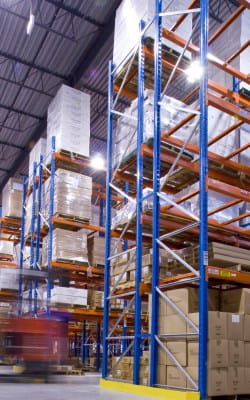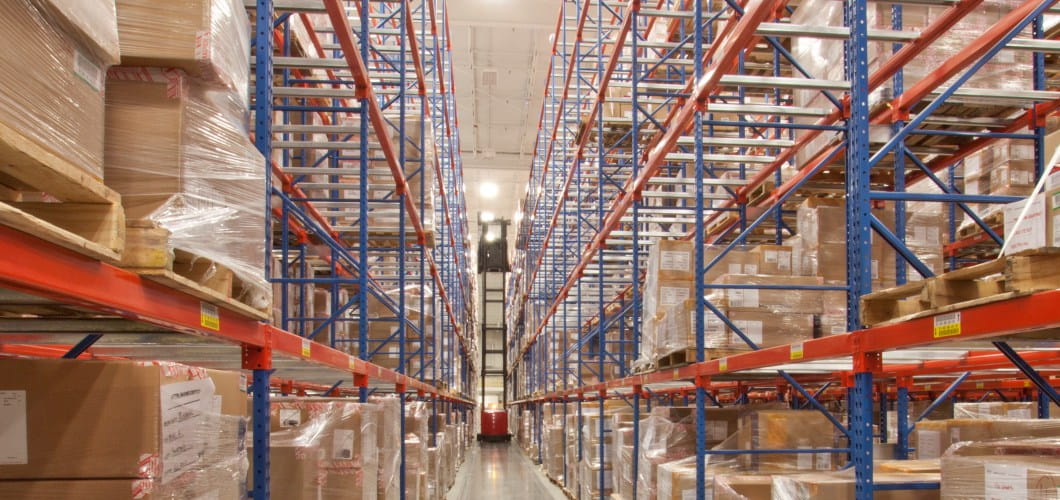KONSTANT® Offers A Wide Variety Of Racking, Accessories & Solutions
-
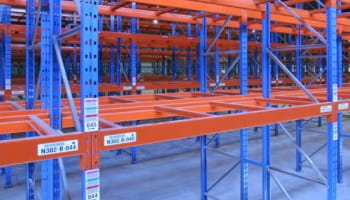
Pallet Racking
Selective pallet racks are an effective method of storing pallets one deep from the aisle while utilizing the vertical space. Konstant® manufactures an assortment of standard structural components for selective warehouse racking. We produce both a welded and a bolted truss with four basic columns. -
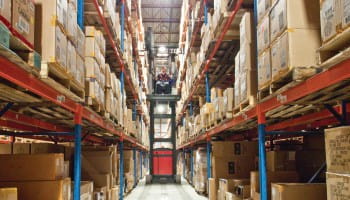
High Density Racking
Konstant's® high density, pallet rack warehouse storage solutions increase the number of pallet positions in your warehouse. Our engineers and designers develop high density pallet rack solutions that significantly increases work flow and pallet positions. We provide high density pallet rack storage solutions that are designed expressly for your warehouse requirements. -
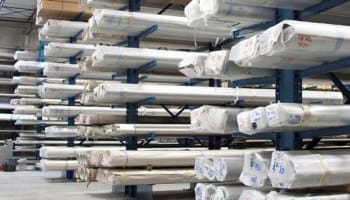
Cantilever Racking
Cantilever racking is ideal for loads that require no obstruction at the pick face, so that bulky and awkwardly sized or shaped products can be safely stored and accessed. This type of racking allows you to use your warehouse space more efficiently – you do not need to waste horizontal space with awkward posts and columns obstructing storage areas. -
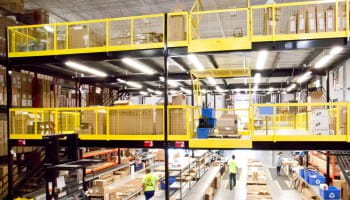
Mezzanines
KONSTANT supplies multi-functional, customizable mezzanines. Warehouse mezzanines provide profit generating floor space without expensive building expansions or relocation costs. Our engineered warehouse mezzanine systems are designed to take advantage of unused overhead space while maintaining open productive space below, in your warehouse. -
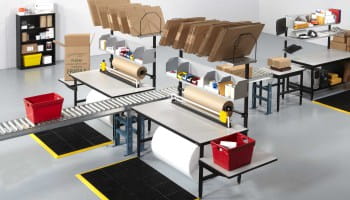
Modular Workstation
We offer numerous types of ergonomic racking solutions to help increase productivity and efficiency in your production and warehousing operations. From sturdy basic workbenches to elaborate, high-efficiency modular workstations, we can provide a solution for your operational needs. -
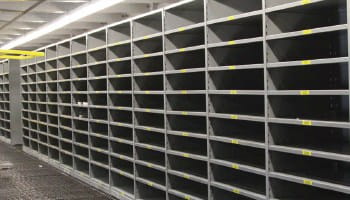
Shelving
Our industrial warehouse racks come in different gauges of steel - the thicker the steel, the more weight the shelving can bear. At Konstant, we sell industrial-quality shelving that is designed for heavy loads typical of storage warehouses. -
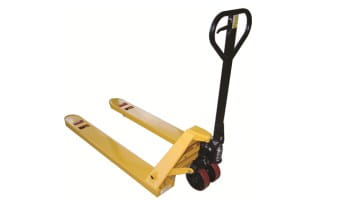
Accessories
Konstant offers a variety of accessories to complement your storage needs. From Hand Pallet Trucks to Rolling Ladders, we can accessorize your operation as needed. -
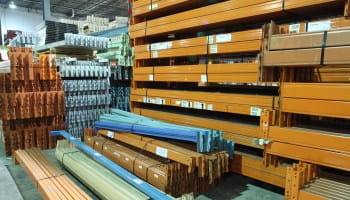
Used Racking
We are Canada’s largest supplier of used racking, shelving and storage systems equipment. Our branches throughout the country carry used material that can provide significant savings over new material. We can help you fill it with used racking, at a price that meets your budget. -
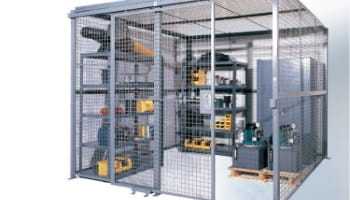
Accessories
Create secure, safe storage in your facility with wire mesh partitions. Whether you're looking for a secure tool or parts storage area, document storage area or general lockup area we can provide a solution to fit your needs. -
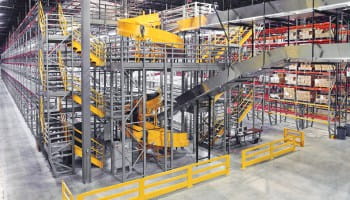
Pick Modules
Konstant® offers a variety of deep lane pallet flow systems with a variety of flow lanes such as single lane rollers or full width rollers to suit your application complete with the in-line brakes to prevent runaway pallets. -
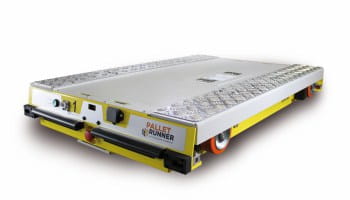
RADIOSHUTTLE
The Pallet Runner® system is a high density storage system that allows you to store multiple pallets in a deep lane configuration. The system also gives you the flexibility of retrieving pallets from any lane with multiple SKU locations without driving into the system.
Contact Our Warehouse Racking System Specialist Today
Please fill out the form below and a Racking, Shelving and System's Specialist will contact you and help you with your needs.
-
How does Push-Back Racking work?
In Push-Back Rack design, pallets are loaded onto wheeled carts which ride on sloped rails. When loading, a forklift operator simply pushes the front pallet deeper into the lane, making room for the next pallet. When retrieving a pallet, a forklift operator removes the front pallet slowly, while the sloped rails ensure that the remaining carts move forward, for easy access when needed. -
What is Push-Back Rack?
Push-Back Racking is an efficient, high-density storage solution that allows you to get the very most out of your available space. Each storage level in a push-back system holds a series of nested rolling carts, operating in a lane which slopes upward away from the pick face. Push-Back Racking can run anywhere between 2 to 6 pallets deep, making it the ideal racking system for FILO and/or high velocity applications. -
What is Selective Rack?
The most traditional, cost-effective racking system, Selective Racking allows every pallet to have its own pick face, for easy selection and organization. By making every pallet immediately identifiable, Selective Racking works for both LIFO and FIFO applications with multiple SKUs. While Selective Racking is the fastest option when it comes to pick velocity, there are other racking options that utilize square footage more efficiently. -
What is Pallet Racking?
Pallet Racking is a storage system designed to store materials that are supported on pallets. A Pallet Racking system allows you to maximize storage by utilizing the vertical space in your warehouse, rather than simply bulk-stacking pallets on the floor. There are multiple types of Pallet Racking systems, tailored to the specific needs of your industry and your available space. -
How do you design a warehouse rack?
There are many factors to consider when designing a warehouse rack storage system. Key factors are selectivity, accessibility, locations, safety, pick velocity, inventory, and future growth. The design usually begins with the product and the load size, the number of pallets to be stored, the order picking process, and the building’s storage area dimensions. Our experienced sales professionals meet with you to understand the needs of your organization and design the ideal system for your current and future business requirements. -
What are the different types of racks available?
Pallet Racks may be constructed using roll formed steel components, structural steel components or a combination of the two. Roll-formed steel racking is the most cost-effective pallet rack system, where coils of sheet steel are punched and formed into unique frame post and beam profiles. Structural Component racking is priced higher than Roll Formed, however it is far more robust and less prone to damage, due to its sturdy channel construction. Finally, where a rack system consists of Roll Formed and Structural Steel Components, structural end-frames and roll-formed beams are used in combination. Whatever your needs, we have the solution for you. -
What are the different kinds of racking systems?
There are various types of racking systems which can each be tailored to your specific needs and applications. These systems range from low to high density, from FIFO to LIFO, and everything in between. We regularly design storage systems from single selective racking, double-deep, drive-in, push-back, pallet flow, carton flow… whatever your space and your needs are, we’ll properly design the racking system to optimize every cubic foot of your warehouse. -
How much does warehouse racking cost?
As there are several types of storage rack systems available, prices will vary widely based on your needs and selection. As a general rule of thumb, costs vary from $75 to $450 per pallet position, depending on the specific rack type. -
What is Narrow Aisle racking?
Narrow Aisle racking is a storage system designed specifically for aisles ranging between 8 - 10 feet in width. We also offer a Very Narrow Aisle racking system, designed for aisles approximately 6 feet wide. One advantage to Narrow Aisle racking is the reduction of forklift aisle space, freeing up space for additional storage. As traditional sit-down counterbalance requires a 12-14 foot aisle to right angle stack, Narrow Aisle racking makes use of stand-up reach trucks, leaving more space for efficient storage solutions. -
What is Drive-In racking?
Drive-In Racking is a series of storage tunnels with angle rails on either side at multiple levels, to support the pallets. Lift trucks can drive into any given tunnel, to retrieve or put away pallets. This allows for the racking system to be up to 10 pallets deep. This high-density storage system is best for LIFO application and is the least expensive high cubic utilization option. This type of storage system is also available in Drive-thru racking with FIFO loading/unloading, however in this instance, additional bracing is required for stability. -
Should Pallet Racking be bolted down?
Pallet racking requires firm anchor points. Anchor bolts are used to secure storage racks to the concrete floor and are designed to resist uplift forces. They not only ensure that the geometry of the rack is maintained but also safeguard against minor impact. Specifying the correct anchor bolts is critical for the installation of your racking system. -
What is the leading cause of warehouse rack system failures?
Storage rack failures are typically caused by one of more of the following:
1. Damaged Rack Components
2. Loading Racks beyond Allowable Limits
3. Modified / Reconfigured Racks without Proper Evaluation
4. Inadequate Forklift Operator Training
5. Intermixing Rack Components from Various Manufacturers
6. Change in Operation or Material Handling Equipment without Consideration of Rack Interaction
To minimize the risk of a storage rack collapse, one should always purchase rack systems that have been designed to applicable standards, that are installed by competent personnel, and that are used and maintained in accordance with the rack manufacturer’s instructions.
Any modifications to a rack system must be evaluated and approved by the original rack manufacturer or a Professional Engineer. -
Are rack inspections required?
Jurisdictions across the country enforce regulations, such as the Occupational Health and Safety Act (OHSA), require employers to maintain a safe workplace. This includes ensuring that structures are capable of supporting the loads applied to them and that equipment is maintained in good condition.
Regular rack inspections are required to identify any visible damage or other conditions that could affect the load capacity or performance of the rack structure. The frequency of rack inspections must, as a minimum, ensure compliance with local regulations.

